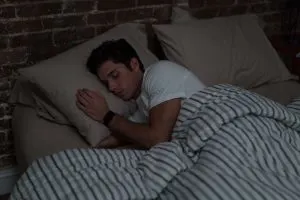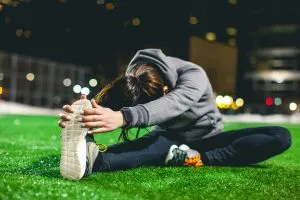Topics
- Article
Fact or Fiction: Does Exercise Close to Bedtime Harm Sleep Quality?

If you turn to the Internet for advice about improving sleep quality, you will find near- consensus on the evils of late-night high-intensity exercise, but can you believe everything you read on the internet?
By their very natures, exercise and sleep demand opposite responses from our bodies; exercise raises body temperature while natural sleep onset is typically preempted by a decrease in body temperature and exercise produces activating hormones including adrenaline and cortisol which amp us up, while sleep requires us to wind down. Given this, why question the veracity of this widespread advice?
In 2013, the National Sleep Foundation conducted a large-scale survey called the “Sleep in America Poll” which focused on the relationship between exercise and sleep. Unsurprisingly, the poll found that people who exercised (at any intensity level) slept better than did people who did not exercise at all. They also broke down exercise timing relative to bedtime into two groups by separating exercise more than 4 hours before bed from exercise less than 4 hours before bed. Following vigorous to moderate exercise days, the percentage of people reporting improved sleep quality who exercised within 4 hours of bed (55%) was not statistically significantly different from the 54% of people reporting improved sleep quality who exercised at vigorous to moderate levels more than 4 hours before bed – not at all the detriment to sleep quality that the myriad of listicles warning against getting your late night sweat on would make you think.
So what’s going on here? It seems like there are two opposing effects on sleep (1) exercise at any intensity during the day improves sleep quality at night and (2) exercise close to bedtime may make it harder to fall asleep. What it comes down to then, is which is the stronger driver of sleep quality – do you get more benefit from exercise than you get harm from exercise lateness such that the positive effect of (1) outweighs the negative effect of (2) or does the opposite happen where the positive effect of (1) is outweighed by the negative of (2)? This, to us at WHOOP, is the beauty of human physiology, because the answer is a big, fat “it depends!”

For illustrative purposes, let’s say its 9 pm, you haven’t had time to exercise yet, and are trying to figure out if it’s a bad idea to go for a quick run. Several factors must be considered when determining if you personally (and not merely the “average athlete” or even the “average 25-year-old female elite sprinter”) will benefit from getting a few miles in. These factors include obvious things like that night’s intended bedtime (if I race 10 miles and try to curl up on the finish line and fall asleep within 30 seconds of finishing, I’m going to have a bad time of it), so the National Sleep Foundation’s poll may be misleading simply because they lumped everything into binary “more than 4 hours” and “less than 4 hours” categories, which may mask important differences between, for example, 0-1 hours and 1-4 hours.
It is therefore difficult to conclude how these results would translate to real-world exercise situations and doesn’t help our hypothetical athlete wondering if he should go for a 9 pm run. To understand the real-world implications of late night exercise, we turned to our data.
Looking to WHOOP Data: Exercise is Good for Sleep
Before diving in, several key differences between the WHOOP data and the NSF data should be noted. Specifically:
- The NSF data was collected by survey, and reports of sleep quality may not align with true sleep quality. In a white paper released last year, we presented evidence that self-reported energy levels upon waking up are poorly correlated with objectively measured sleep duration, r = 0.295, meaning the NSF’s self-reported data should be considered cautiously.
- The NSF study used 1000 participants chosen to be “representative of the US population, age 23 to 60.” The WHOOP population, however, is not representative of the whole US population, but rather represents a self-selecting group of dedicated athletes with both the means and interest to invest in the betterment of their athletic performance. To better mimic the demographics of the NSF study, all data presented herein is drawn from 23 to 60 year olds, but we are unable to further match the demographics of the NSF survey simply because we are limited in this area by the comparatively narrow demographics of our users.
The NSF report showed that 51% of people perceive their sleep quality to improve on days they exercise. Interestingly, this phenomenon was strongest in those they characterized as vigorous exercisers, with 62% of that population reporting improved sleep quality on exercise days. To reproduce this data, WHOOP looked at the most recent 10,000 sleeps collected by its users after either vigorous exercise days or rest days. WHOOP measures the cardiovascular strain of a day on a scale from 0-21, the motivation for which is explored elsewhere. For this report, “vigorous” was defined as a strain over 15, a score one might expect to receive for 45-minutes of running at 70% of VO2max and “rest” was defined as below 8.0, which roughly corresponds to the level seen on days on which any amount of exercise is undergone. 17% of the 10,000 sleeps fell into the vigorous category, 28% met the “rest” category criteria and the remaining sleeps were categorized as light to moderate activity days. Table 1 below shows the differences in sleep efficiency (percentage of time dedicated to sleep actually spent asleep) by activity level.
Table 1. Sleep Efficiency by Activity Level
Activity Level
Average Relative Sleep Efficiency (+/- standard deviation)
Vigorous
1.004 +/- 0.04
Light to Moderate
1.001 +/- 0.04
Rest / None
0.999 +/- 0.04
As reported by the NSF, WHOOP data shows that following exercise, the average user will experience a sleep efficiency that may be marginally higher than that experienced on days when they rest, and that this effect may increase in magnitude as vigor increases. We note, however, that the effect size observed here is small and not statistically significant, suggesting that there are almost certainly many variables at play. While beyond the scope of this report, it is interesting to consider that the NSF reported on user-perceived sleep quality while the WHOOP data presented in Table 1 is objectively measured sleep quality; the difference in significance of our findings might allude to the presence of a conformation bias or placebo effect where the expectation of improved sleep quality causes users to perceive and therefore report on higher sleep quality than may have truly been experienced.

One variable which is often suggested is workout timing relative to bedtime, when evaluating this variable, the NSF survey separated workouts into binary categories (1) within 4 hours of bedtime, and (2) more than 4 hours before bedtime. They did not see differences in sleep quality between these two groups and therefore concluded that “exercise, or physical activity in general, is generally good for sleep, regardless of the time of day the activity is performed.”
To check for this phenomenon in our data, the most recent 45 days’ worth of sleeps were gathered. These were then filtered for having a moderate to vigorous activity at some point during the day. As in the NSF study, exercise within 4 hours of bedtime was significantly less common than exerciser earlier in the day, representing about 11% of the data. Following moderate to vigorous exercise within four hours of bedtime, the average WHOOP athlete saw sleep efficiency that was 0.999% of their baseline sleep efficiency, while the same intensity of exercise completed more than four hours before bedtime resulted in sleep efficiencies that were 1.001 times their baseline efficiencies. In both cases, baseline was defined as their average over the last 45 days, and people were excluded from this analysis if they had fewer than 15 recorded sleeps during this period. We note that neither result was statistically significant nor practically significant. A change of 0.001% in efficiency per 8-hour block spent in bed would result in less than one minute of lost or added true sleep, which is unlikely to result in practical performance differences during the day.
What Does this Mean for You?
Like so many other physiological phenomena, huge inter-individual factors are at play, and different people are going to be differently sensitive to different things. Take, for example, one elite male runner who in the last 45 days has exercised at moderate to vigorous intensities both within and prior to four hours before bed. In his case, there is still not a statistically significant but much larger than previously observed difference between the sleep efficiencies following exercise within four hours of bedtime (86.3%) and that following exercise completed earlier in the day (88.3%). Compare this to an average female runner training for her first marathon who statistically significantly sleeps better following late-night exercise (sleep efficiency mean = 96.4%) than following earlier exercise (sleep efficiency = 93.2%). While we could provide endless examples, these two illustrate the fact that the direction and magnitude of the correlation between exercise timing and sleep quality are highly variable, so the only way to know if it is ok to go for that 9 pm run is to try it.